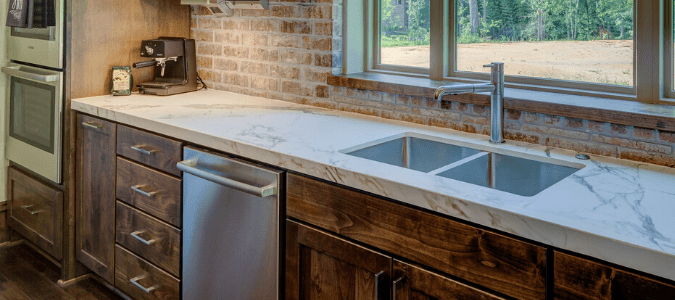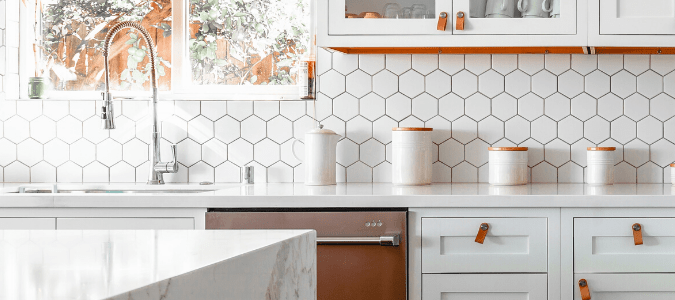If you begin noticing that the water coming out of your kitchen faucet doesn’t have as much pressure as it should, the first thing to check is whether it’s a whole-house issue. Are all the taps affected, or only the kitchen sink? If the kitchen is the only tap with low pressure, it’s time to consider the potential causes of low water pressure in a kitchen sink so you can determine what might be causing it, and fix it. The next thing to look at is whether you only have low water pressure when the water is hot or cool, or if the water pressure is low no matter the temperature.
According to Michael Marugo, Plumbing Operations Manager at ABC Home & Commercial Services, the most common causes of low water pressure in a kitchen sink are a clogged aerator or a clogged cartridge. The aerator is the part of the faucet that is at the very end of the spout; it is the last thing the water touches before it comes out into the sink. Most aerators become clogged over time due to mineral deposits in hard water. Fortunately, they are simple to clean when they become clogged. Simply unscrew the aerator, remove the metal or plastic screen inside and rinse away any debris.
To get the aerator extra clean, you can soak it in vinegar overnight and then rinse it off the next day before reattaching it to the end of the faucet. In most cases, that should clear the clog and improve the water pressure. It’s also a good idea, every few months, to tie a gallon bag of white vinegar over the end of the faucet overnight. This should help to prevent future clogs in the aerator and extend the life of your faucet over time.
If you’re only having an issue with hot or cold water, you don’t have an aerator problem. If you’re handy, you can try checking the hot and cold water supply lines. You can start by shutting off the hot and cold valves below the sink. Then, you would disconnect the lines and let them run into a bucket. Then, turn on the valves one at a time to get proper water flow. If you do get proper water flow, then you have a problem with the cartridge.
If you cleaned the aerator and the water pressure is still low, the next thing to check is the cartridge, which is located within the handle. (Note that if you have a kitchen faucet with two handles, one for hot water and one for cold, you don’t have a cartridge faucet; instead, you have a compression faucet.) A quick way to check whether the cartridge is clogged is to run the water while the aerator is off the faucet. If the water pressure is still low, the cartridge may be the culprit. In order to check it, depending on what style of faucet you have, you’ll need to pop the top off the handle or remove it altogether by removing the set screw located in the bottom of the handle. Replacing the cartridge is a complex plumbing task that should be left to a licensed professional.
As we previously mentioned, if you’re experiencing low water pressure in your kitchen sink (or any other faucet in the house), one of the first things to check is whether the aerator is clogged. But many homeowners don’t understand the role of a faucet aerator.

What Is a Faucet Aerator?
If you’ve ever noticed that the very end of the faucet—the part where the water comes out—is able to be unscrewed, you’ve also probably noticed that there is a small, round, mesh screen inside the metal part that unscrews. This mesh screen is the faucet aerator; it is made either of plastic or of metal, and it has several purposes.
The aerator’s primary function is to mix air with the water rushing out of the faucet in order to reduce the water flow and also reduce splashing. If you unscrew the end of the faucet and turn on the water, you’ll see just how much more force water flows out of the faucet into the sink when the aerator is not present. What the aerator does is to break the single, solid stream of water rushing through your home’s water pipes and faucet into several tiny streams. This conserves both water and energy, and in the end, the result is that the person using the faucet feels like the water pressure remains high.
Sediment and debris can build up behind the aerator over time, leading to clogs that reduce the water pressure. This is especially true in homes with hard water. Calcium deposits in hard water can further clog an aerator. If your home has particularly hard water, it may be worth considering the pros and cons of purchasing a water softener.
When the water pressure is low, the first thing to do to try to resolve it is to clean out the aerator. As we mentioned earlier, it’s also a good idea to soak every faucet in your home in white vinegar every few months, by filling a gallon bag with vinegar and tying it onto the faucet with the faucet’s end submerged. Again, this is especially helpful in hard-water homes. Along with preventing clogs, periodic vinegar soaks will extend the life of your faucet over time.
In some older homes with original fixtures, the faucets in the home are not equipped with aerators. In this case, it’s a good idea to have a professional plumber install aerators on the faucets in order to reduce water flow and splashing and save on water usage and energy.
Sometimes people notice the water pressure is low, but only when the hot water is running. In that case, there could be a totally different problem.

What if My Hot Water Pressure Is Low but Cold Is Fine?
If you have a sink in your home where the hot water pressure is low but cold is fine, it can indicate an issue with your water heater. Typically, if your hot water heater is having issues that cause low water pressure when the hot water is running, it won’t affect only one faucet in the house. Rather, it will affect every faucet in the house when the hot water is turned on.
Just as with faucet aerators, water heaters build up sediment over time if they aren’t flushed regularly. Tank and tankless water heaters should be flushed annually, or even more often if the water is very hard. Calcium and other types of sediment in the water build up over time, and if they aren’t flushed out, they can reduce the water heater’s capacity to heat water, increase its energy usage and lower the hot water pressure throughout the house. If you’re running out of hot water faster than before and your hot water pressure is low, it’s probably time to get your water heater flushed.
If your water heater has sediment buildup that is causing low hot water pressure in your sinks, a licensed plumber can flush the water heater to resolve the problem. If it hasn’t been flushed in five years or more, however, flushing may not work. There may be too much sediment and debris built up inside the water heater for flushing to be effective. If you can hear popping sounds coming from your water heater, this is a sign that there is so much sediment buildup inside that it’s too late to flush, and the water heater will likely need to be replaced.
This is why it’s a smart idea to contact a plumbing professional to perform routine maintenance on your water heater in order to avoid plumbing problems that would otherwise occur. Regular water heater maintenance will extend the life of your water heater, reduce energy use along with your gas or electric bills and keep your hot water flowing well.
ABC Can Resolve Water Pressure Problems
Trying to fix problems with your water pressure can take a lot of trial and error. Instead of spending your precious free time trying to diagnose the problem, contact ABC Home & Commercial Services. Our licensed plumbers will be able to quickly locate the problem and then get to work on resolving your plumbing issue. Also, if your area has hard water, you can rely on us for honest advice on what size water softener would be best for your home.
